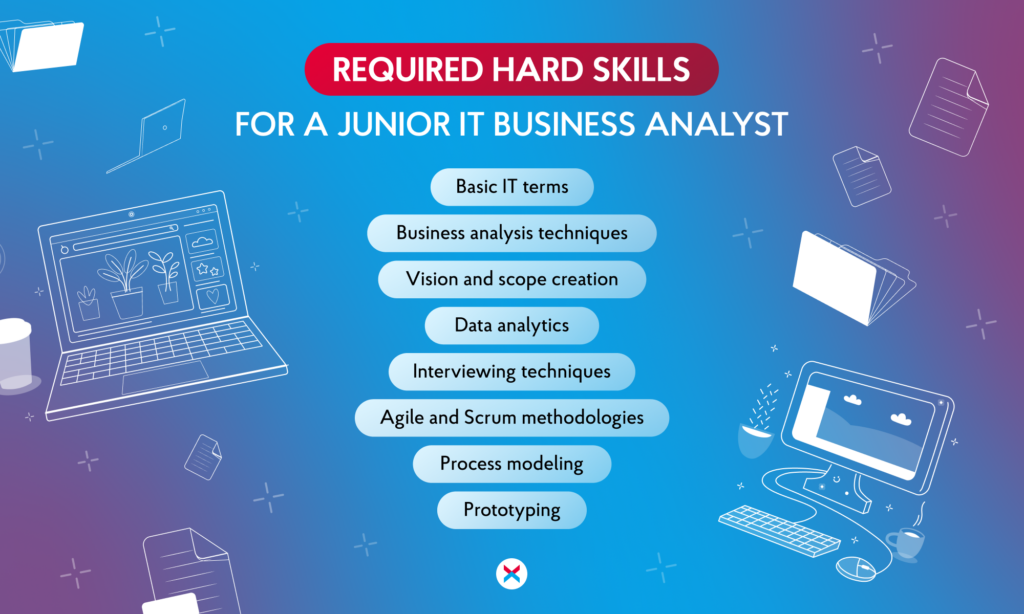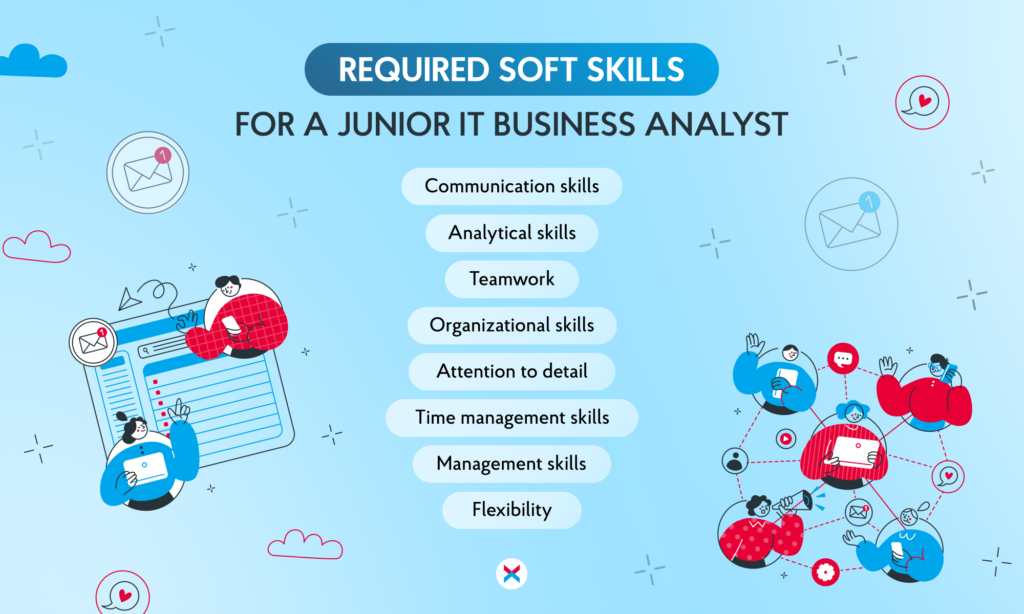Are you wondering what it would be like to work as a business analyst in the IT industry, but have no one to ask? You’re in the right place!
In this article, we’ll show you what tasks IT business analysts work on when they are assigned to a project, what skills and certifications you need to become one, and what your salary and career prospects are if you work as a BA.
What’s more, we’ve also collected a list of similar roles (with useful links and information!), so if you have what it takes to become a BA, you will also have a range of other options to choose from.
Let’s get started!
What is an IT Business Analyst?
An IT business analyst is the bridge between technical solutions and business goals, connecting the client with the team of IT specialists. This role is essential in driving the creation of solutions that satisfy business needs.
Basically, the IT business analyst is the specialist who collects and documents the input information from the customer, end users, programmers, and other participants in the development process. Then they turn it into requirements, according to which the team develops the software.
What are the Responsibilities of an IT Business Analyst?
The following 7 steps and their content and order may vary depending on the chosen development methodology, the complexity of the project, and the number of team members. But in general, a typical project and the tasks of a business analyst look like this.

1. Identify the Business Idea
Once you have been entrusted to work on a project, the first and most important task is to identify the business idea and understand in detail what you will be working on. Then it is worth working out the stakeholders with whom you will interact, both those who are interested in the success of the project and those interested in its failure.
2. Analyze the Competitors & Target Audience
Once you understand the business idea, continue to analyze your competitors and target audience to make sure the idea really takes off. For example, you can survey potential end-users (gather a focus group, conduct an interview, or create a questionnaire), conduct observation of users (if they are nearby), or rummage through documents that describe business processes.
3. Identify the Scope and Risks
As a business analyst, you need to understand and capture the business idea, form an understanding of the scope of the tasks, and process the technical and business risks. When everything is ready, you can evaluate the project together with the team and plan the development stages and deadlines.
4. Approve the Development Plan
Then go to the client, approve the vision, and make revisions based on the results of the discussion. When the client is satisfied with everything, you can move on to the implementation of the project.
5. Create a Prototype
At this first stage, the business analyst conceptualizes what the product will ultimately look like. “Model” means not only the visual part but also the logical structure of the system. Analysts, usually with the help of designers, create a prototype. Then, together with developers, form the key hypotheses of the architecture and help testers think through the process of evaluating the future product.
6. Identify Functional and System Requirements
Next comes the design phase, where you should implement the plans and move directly to development. At this stage, business analysts identify and document detailed functional and system requirements for the product and approve technical details with the client and the team.
As a result, the analyst creates the so-called baseline requirements: the basic requirements for the product. This is the basis with which you will have to work further and where you will have to make changes. As practice shows, you never leave a project with exactly the same requirements as you came in with.
7. Provide Product Support
The final stage of development is product support. If the development is product-based, you answer user questions, help developers fix bugs, and compile user manuals. In a word, everything is possible to support everyone who is interested in the development.
In the case of outsourced development, the analyst’s involvement in this process is reduced: usually, a specialist supports developers who fix bugs and modify small features of the already released product.
A Day in the Life of an IT Business Analyst
Now you can feel yourself in the role of an IT business analyst and understand how a specialist manages to cope with all the tasks from the customer while adhering to deadlines and not putting out fires. If you always pay attention to the following tips, you’ll have a great day at work!
- Organize a meeting with your team. Before you start implementing the idea, it is important to make sure that the IT business analyst and the team are on the same page and have the same understanding of the details of the project. To do this, the specialist organizes a meeting at which he talks about the basic requirements of the customer, discusses in advance the possible difficulties, and thinks about ways to solve them.
- Analyze the requirements. After communicating with the team, you, as the IT business analyst, should gather, record, and analyze the requirements. Based on the information received from the customer and the team, you can prioritize and visualize the processes with diagrams, schemes, and prototypes.
- Get everything approved. You have understood the subject matter of the business, thought through the conceptual solution, and therefore are ready to present the idea to the customer and get the long-awaited approval.
- Give the green flag to the developers. Next, the direct responsibility of the business analyst is to advise the development and testing team on putting the product into development.
Business Analytics Tools and Software
An IT business analyst’s arsenal includes more than 100 techniques, tools, and approaches for all occasions. Among them, one can single out those that a business analyst uses for almost every task and at all stages of their activities. Below is a more detailed breakdown of them.
The top IT business analytics tools:
- General-purpose tools (Microsoft Excel, Word, Zoom)
- Prototyping tools (Balsamiq, Figma, Axure RP)
- Modelling tools (Diagrams.net, Visual Paradigm, Lucid Chart)
- Project management tools (Jira, ClickUp, Rally)
- Documentation (Confluence, Notion)
- Technical tools (DBeaver, Fiddler, Notepad++)
- Personal tools (Grammarly, Trello, Todoist)
If you’d like to learn more about the tools used by business analysts, check out our dedicated article!
Business Analyst Techniques
Decomposition, or Work Breakdown Structure (WBS)
This is the basic technique of business analysis, which allows you to divide a large task into understandable parts and put everything in order. Here’s an example. Let’s say you need to build a house. You should divide the task into blocks: foundation, walls and partitions, roof, and interior work.
Now, each of these blocks is divided into smaller parts, such as measuring, cutting, sanding, etc. As a result, you get a clear list of tasks that allows you to implement the ones you have in mind. As a business analyst, you do very much the same thing with the IT project.
Prioritization
This is the definition of a step-by-step order of tasks. Usually, both the IT business analyst and the project manager have a huge amount of work. It’s impossible to do everything at once, so it’s worth determining what’s more important and useful. This technique is exactly the answer to these questions.
It might seem easy, but as a business analyst, you can receive contradictory information from the client and the development teams on what is really important. You need to possess a deep understanding of development and business processes, as well as the right order of business operations.
Determining the Evaluation Criteria
As a result of each task, the specialist expects to get a certain result. How do you know that you have achieved it? There are predetermined evaluation criteria that can help you check if you really achieved the result.
For example, you want to eat. The main criteria are to get to a place with food quickly and to have a good meal. And to determine how well the experience meets your expectations, it is worth referring to the help of evaluation criteria. A business analyst decides the evaluation criteria for the IT project, so it is easy to later identify areas of improvement.
IT Business Analyst Certifications
Certifications are a great way to prove your knowledge and experience, or at the very least to add a shiny badge of honor to your resume or LinkedIn profile.
The best certifications are coming from universities, of course. A bachelor’s degree or a master’s degree in information technology, computer science, business administration, business operations, or something similar is invaluable.
Most business analyst courses also provide you with a certification. However, some certifications and exams are more widely recognized than others.
Let’s take a quick look at the top international BA certifications:
- International Qualification Board for Business Analysts (IQBBA) certifications. They focus on the IT field, and offer 2 types of certificates: foundation-level and advanced-level.
- International Institute of Business Analysis (IIBA) certifications. From entry certificate to professional-level, they offer 5 types of certifications. The focus is generally on the BA profession, with no specific field.
- Project Management Institute (PMI) certification. They focus on the connection between project management and business analysis, and offer 1 certificate in business analysis.
- International Requirements Engineering Board (IREB) certifications. As their name suggests, they focus on BAs within the field of engineering. Their 3 certificates range from foundation-level to expert.
However, if you don’t aim to work at Google or some equally famous company, you’ll do just fine by becoming a locally certified business analysis professional. Most businesses that offer business analyst jobs are more interested in your actual experience and what skills you bring to the team than in your diplomas or other papers.
Required Skills for an IT Business Analyst
Business analysis requires a special kind of skillset that you can gain through BA courses or work experience. If you’re unsure about what counts as a good skill to put on a resume, visit this article!
Here’s the list of the top Junior IT Business Analyst skills:

Business Analyst hard skills:
- Basic IT terms
- Business analysis techniques
- Vision and scope creation
- Data analytics
- Requirements elicitation and interviewing techniques
- Agile and Scrum methodologies
- Process modeling
- Prototyping

Business Analyst soft skills:
- Excellent communication skills
- Analytical skills
- Teamwork
- Organizational skills
- Attention to detail
- Time management skills
- Leadership and management skills
- Flexibility
It is also a good idea to check the descriptions of business analyst jobs, as they usually list the skills required for the position. In general, business analyst roles require a deep understanding of business objectives, domain knowledge, and data analysis skills. They can also ask for extensive experience in other business analyst analyses areas, such as cost-benefit analysis.
Do you wanna learn such skills? Let’s talk about the best business analysis courses next!
IT Business Analyst Training
IT business analyst jobs require very specific skills and knowledge. It is a serious advantage if you also have experience in other IT fields, but not necessary; several courses offer all the knowledge you need from zero to hero.
At NIX, we also offer free IT Business Analysis courses, from beginner to more advanced. Even someone with a psychology degree and HR experience can become a BA after completing our courses (true story!).
In the beginner Business Analyst training course, the program usually includes IT basics, development methodologies, software requirement basics, the theory, core concepts, and the mindset of an analyst, as well as the necessary soft skills.
In the more advanced, trainee-level BA course, students can learn how to analyze business ideas and requirements and how to create Vision and Scope documents. They also learn about Agile and Scrum methodologies, mobile application prototyping, and much more.
Safe to say that you absolutely need this knowledge before you can build the Business Analyst career you dream of!
IT Business Analyst Career Outlook and Salary
We’ve arrived at the number one question on everyone’s mind: how much does a business analyst earn? Is it worth it to choose IT BA as a career path?
The short answer is YES. The long answer is IT DEPENDS. IT positions pay very well in general, and becoming a BA does not require much coding experience.
However, to become a truly high-paid BA specialist, you need a ton of knowledge and experience, with several years on complex, international projects. It doesn’t happen overnight, and just like with every career path, you need to put effort and time into climbing the ladder.
Without further ado, let’s see the ranges of IT Business Analyst salaries, based on the calculations of HR portals.
Gross IT Business Analyst average salary in Hungary, in 2025
| Junior IT Business Analyst Salary | 750 000 HUF – 1 000 000 HUF |
| Medior IT Business Analyst Salary | 1 000 000 HUF – 1 400 000 HUF |
| Senior IT Business Analyst Salary | 1 400 000 HUF – 1 700 000 HUF |
Are you getting excited about these prospects? Besides the high salaries, NIX offers a competitive compensation package with healthcare and sports benefits. Check out our Business Analysis vacancies now and apply immediately!
IT Roles Related to a Business Analyst (With Salaries)
If you’re interested in the field of IT business analysis but are curious about other career options as well, we have a list of positions that you could also try. They require a similar set of skills to business analyst jobs, but the day-to-day tasks differ.
| IT position | Role description | Salary range (based on seniority) |
| Data Analyst / BI Engineer | Focuses on business data analysis to support decision-making. Often collaborates with the business analyst. | 750 000 HUF – 1 700 000 HUF |
| IT Project Manager | Oversees project execution and delivery. Often works closely with the business analyst to implement requirements. | 750 000 HUF – 1 700 000 HUF |
| Systems Analyst | Often overlaps with BA. Analyzes system needs and specs based on business requirements. | 750 000 HUF – 1 700 000 HUF |
| SAP Consultant | Works on SAP systems. Some roles are very business analyst-like in gathering business requirements and configuring systems. | 900 000 HUF – 2 100 000 HUF |
| Product Owner | Defines the product vision and manages the backlog. Often handles business requirements like a business analyst. | 800 000 HUF – 1 800 000 HUF |
| IT Consultant | Advises businesses on IT solutions. Can include a business analyst-style of data analysis of business goals. | 950 000 HUF – 2 100 000 HUF |
As you can see, at NIX, we’re also searching for specialists for a few of these positions. However, if you’re interested in other IT jobs that we offer as well, check out our vacancies and apply!
Effective processing of the business idea and the need for users and customers are integral to the success of the project. That’s why the demand for business analysts grows every year.
An IT business analyst acts as a conduit between the business and the development teams and breaks into more and more domains. Because of the flexibility of business analysis as a profession, as well as the wide range of techniques and knowledge, an experienced professional can turn an abstract idea into a tool that will change the world for the better.






